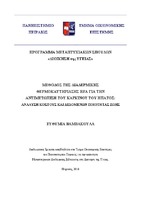Μέθοδος της διαδερμικής θερμοκαυτηρίασης RFA για την αντιμετώπιση του καρκίνου του ήπατος : ανάλυση κόστους και δεδομένων ποιότητας ζωής
Method of perrcutaneous radiofrequency ablation for the treatment of liver malignity : cost analysis and data quality of life

Προβολή/
Λέξεις κλειδιά
Καρκίνος ; Νοσοκομειακές δαπάνες ; Δημόσια νοσοκομεία ; Δαπάνες υγείαςΠερίληψη
Λαμβάνοντας υπόψη το επιχειρηματικό πρότυπο, πολλοί οικονομολόγοι προσπαθούν
να αναλύσουν την οικονομική συμπεριφορά των νοσοκομείων, πέρα από τον
κοινωνικό τους χαρακτήρα. Οι συζητήσεις γύρω από αυτόν τον τομέα επικεντρώνονται στην διαμόρφωση κάποιων εργαλείων - δεικτών αποτελεσματικότητας
και παραγωγικότητας των νοσοκομειακών μονάδων, με απώτερο σκοπό αυτά να
προσδιορισθούν περισσότερο, λόγω και του συνεχούς αυξανόμενου κόστους των
υπηρεσιών υγείας διαχρονικά. Λαμβάνοντας υπόψη ότι o καρκίνος του ήπατος είναι ο
έκτος συχνότερος παγκοσμίως. Στην Ευρώπη, περίπου 10 στους 1,000 άντρες και 2
στις 1.000 γυναίκες θα αναπτύξουν καρκίνο του ήπατος κάποια στιγμή στη ζωή τους.
Σε παγκόσμιο επίπεδο είναι συχνότερος στη Νότιο-Ανατολική Ασία και τη Δυτική
Αφρική. Αυτό οφείλεται στο γεγονός ότι η λοίμωξη από τον ιό της Ηπατίτιδας Β, η
οποία αυξάνει τον κίνδυνο ανάπτυξης καρκίνου του ήπατος, εμφανίζει αυξημένη
συχνότητα σε αυτές τις περιοχές. Στις ΗΠΑ και τη Νότια Ευρώπη, απαντάται πιο
συχνά ο ιός της Ηπατίτιδας C σαν αιτία καρκίνου του ήπατος. Το 2008, περίπου
40.000 άντρες και περίπου 20.000 γυναίκες διαγνώστηκαν με καρκίνο του ήπατος
στην Ευρώπη. Η μέση ηλικία κατά τη διάγνωση είναι μεταξύ 50 και 60 ετών, αλλά
στην Ασία και την Αφρική είναι συνήθως μεταξύ 40 και 50 ετών. Έτσι η οποιαδήποτε
μέθοδος αντιμετώπισης του καρκίνου του ήπατος είναι σημαντική για την ερευνά της
όσο αφορά την αποτελεσματικότητα της και την οικονομική της ανάλυση. RFA
τεχνική αντιμετώπισης της κακοηθείας του ήπατος θεωρείται μια νέα μέθοδος
ελάχιστα επεμβατική και η καλύτερη επιλογή για ανεγχείρητους ασθενείς.
Στόχος της παρούσας έρευνας η περιγραφική μερική ανάλυση του κόστους της
αναδρομικής έρευνας για τα έτη 2013, 2014 για 149 ασθενείς που πραγματοποιήθηκε
στο τμήμα επεμβατικής ακτινολογίας σε νοσοκομείο Αθηνών, της μεθόδου δια-
δερμικής θερμοκαυτηρίασης για την αντιμετώπιση καρκίνου του ήπατος . Επίσης
καταγραφή από τηλεφωνική ερευνά τις μαρτυρίες των ασθενών με την βοήθεια της
αριθμητικής κλίμακας βαθμονόμησης (Numerical Rating Scale – NRS) της
αξιολόγησης της ποιότητας ζωής των ασθενών πριν από την παρέμβαση και μετά. Η
μεθοδολογία της έρευνας πρόκειται για μια αναδρομική ερευνά, 149 ασθενών (92
άντρες και 57 γυναίκες με μέσο όρο ηλικίας τα 67 έτη ) με 203 ηπατικές βλάβες που
έλαβαν θεραπεία με την μέθοδο της διαδερμικής θερμοκαυτηρίασης ήπατος. Τα έτη
που μελετήθηκαν 2013-2014. Το κριτήριο αποτελεσματικότητας της μεθόδου ήταν η
πραγματοποίηση αξονικής τομογραφίας δυο φάσεων με σκιαγραφικό μέσο αφού
απομακρύνθηκαν τα ηλεκτρόδια. Περιγράφονται τα νοσοκομειακά κόστη που
χρησιμοποιήθηκαν για τους ασθενείς και υπολογίστηκε το συνολικό μέσο ετήσιο
κόστος καθώς και το μέσο κόστος ανά ασθενή. Συγκρίθηκαν τα αποτελέσματα με
αυτά άλλων παρόμοιων μελετών.
Τα αποτελέσματα της έρευνας έκριναν την διαθερμική θερμοκαυτηρίαση ήπατος
αποτελεσματική θεραπεία και ασφαλή για την αντιμετώπιση της κακοήθειας στο
ήπαρ. Παρόλο τους περιορισμούς της έρευνας κρίθηκε απαραίτητη η ταξινόμηση της
θεραπείας στο σύστημα Κ.Ε.Ν. Το μέσο κόστος ανά ασθενή δεν διαφέρει ποσοτικά
με αυτό άλλων διεθνών δημοσιευμένων εργασιών αλλά γίνεται διαφορετική
κοστολόγηση την Ελλάδα. Κρίνεται επιτακτική ανάγκη ανάπτυξης ενός συστήματος
υπολογισμού των τιμών του συνόλου των εργαστηριακών εξετάσεων και της ιατρικής
πράξης στη βάση σχετικών βαρών των συντελεστών παράγωγης, έτσι να προταθεί μια
πραγματική κοστολόγηση για την συγκεκριμένη μέθοδο και κοινή για όλους τους
δημόσιους παρόχους υγείας.


